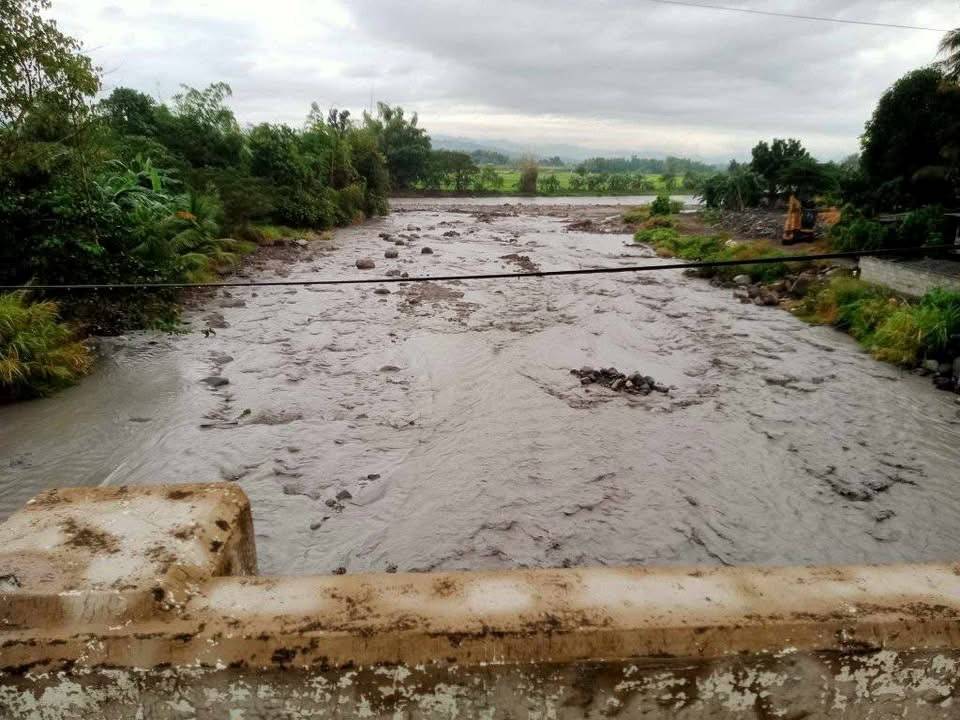Rains trigger lahar flow in 2 Negros Occidental towns near Kanlaon

BACOLOD CITY—Local authorities have heightened their alert as moderate to heavy rains coupled with ash deposited along the slopes of the restive Mt. Kanlaon caused lahar flows in the river that flowed through two municipalities in Negros Occidental.
According to the Philippine Institute of Volcanology and Seismology (Phivolcs), the lahar flowed through Buhangin River, which traverses the towns of La Castellana and Moises Padilla, starting in the afternoon of Feb. 6.
Ptolemy Mañego, science research assistant at the Phivolcs Kanlaon Observatory in La Carlota City, said continuous rainfall transformed ash deposits into mudflow in the Buhangin River.
The Moises Padilla Municipal Disaster Risk Reduction and Management Office (MDRRMO) posted photos of the lahar flow as seen from the Intiguiwan Bridge in the town.
The lahar flowed down from the lower sections of the volcano, according to the MDRRMO.
Minor explosion
A minor explosive eruption was also recorded at the summit crater of Mt. Kanlaon, which occurred at 3:11 p.m. on Thursday and lasted for two minutes based on seismic and infrasound records, Phivolcs said.
The eruption generated a poorly visible plume that rose 600 meters above the vent before drifting southwest, scattering thin ashfall over Santo Mercedes and San Luis in Barangay Sag-ang of La Castellana.
The explosion also generated an airwave 5 kilometers east of the summit crater and heard as a booming sound in Barangay Yubo, La Carlota City and in Barangay Sag-ang in La Castellana, the Phivolcs said.
Sulfurous fumes were also reported in the barangays of La Castellana.
Phivolcs said rains could generate lahar or muddy run-off in the rivers near Mt. Kanlaon.
The upper to middle slopes of the volcano’s edifice have been undergoing inflation or swelling since Jan. 10.
Still restive
Phivolcs has also been monitoring the superheated plumes that have been coming out the volcano’s summit since November last year.
“We already have signs of magma coming out as ash,” said Ma. Antonia V. Bornas, Phivolcs Volcano Monitoring and Eruption Prediction Division chief, to explain the orange light above the crater of Kanlaon Volcano shown in now viral photos taken at 3 a.m. to 5 a.m. on Feb. 2.
Phivolcs reminded residents in both Negros Occidental and Negros Oriental living close to the volcano that alert level 3 (magmatic unrest) still prevails over Mt. Kanlaon.
This means that the magmatic eruption that occurred may be followed by similar short-lived explosive eruptions in the short term, which may generate pyroclastic density currents (PDC) within the 6-km radius area on the summit.
Residents living within the 6-km radius of the summit crater have been staying in evacuation centers since the Dec. 9, 2024 eruption, as Phivolcs warned of the danger of lava flows, rockfalls, pyroclastic density currents or PDCs and other related hazards.
The volcano’s December eruption has affected 23,623 residents in seven Negros Occidental localities but from a high of over 10,000 evacuees, there were only 5,825 persons from 1,859 families who remained in evacuation centers as of Friday, records from the Department of Social Welfare and Development (DSWD) showed.
There were also 5,543 persons (1,760 families) who have taken shelter with relatives and friends, the DSWD said.
In Canlaon City in Negros Oriental, 3,853 individuals from 1,200 families were still inside government shelters while 2,854 (899 families) were staying with their relatives.
These nearly 10,000 villagers from danger zone have not been allowed to return home since December last year, with more residents to be evacuated if the volcano’s restiveness escalates.
The Phivolcs and national disaster response authorities have advised local governments surrounding the volcano to prepare their communities within the PDC hazard zone for subsequent evacuation in case hazardous worst-case explosive eruption becomes imminent.
“Increased vigilance against potential syn-eruption lahars and sediment-laden streamflows in channels draining the edifice is strongly advised should intense rains occur during eruptive unrest,” Phivolcs said.

















